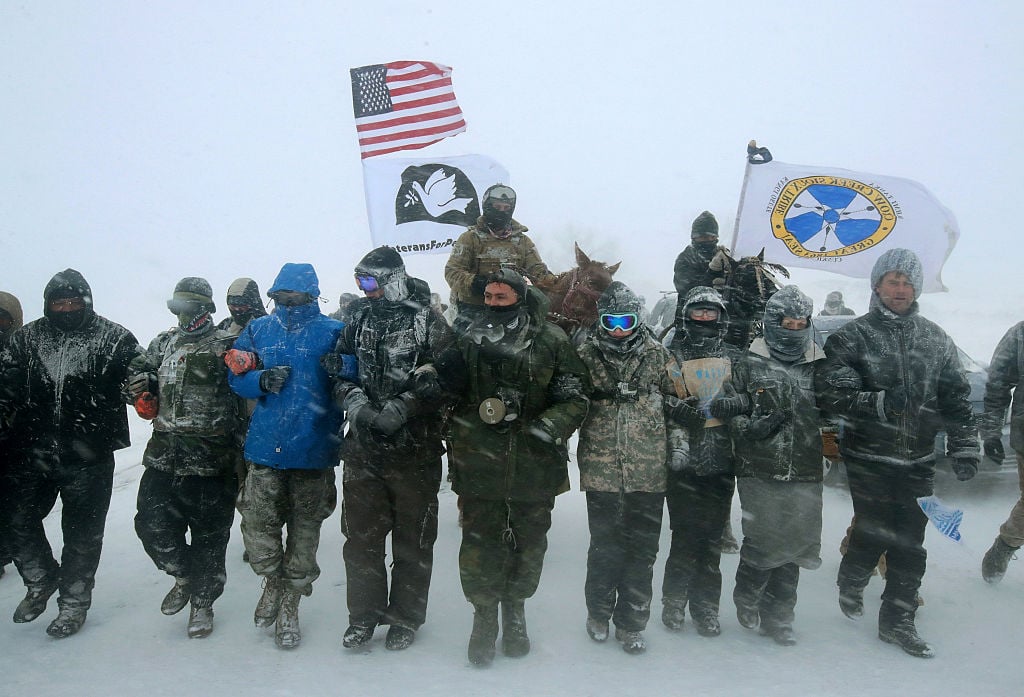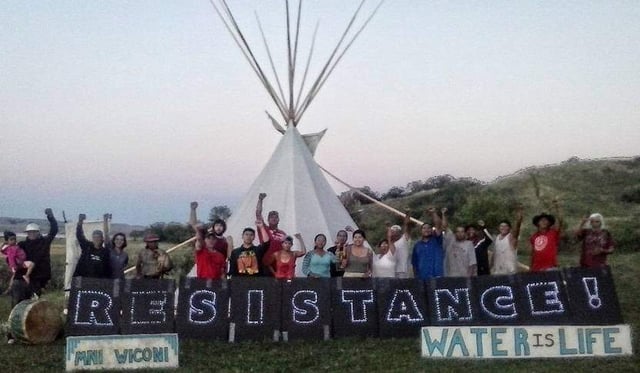
This is part one of a seven-part series produced in partnership with Grist as a companion to the SLAPP’d season of the Drilled podcast. You can see all seven pieces together in a beautiful layout over on Grist’s site, where you’ll also find other great climate stories.
In March 2025, a jury ordered the environmental giant Greenpeace to pay $666 million to the companies behind the Dakota Access pipeline.
The companies argued that Greenpeace was responsible for protests near the Standing Rock Sioux Reservation nearly a decade ago that drew thousands.
But Indigenous leaders, water protectors, activists, and court records agree: Greenpeace played a bit part in the Standing Rock movement, at best.
“They're trying to point the finger at Greenpeace," said Honorata Defender, a Standing Rock Sioux tribal member who helped start the movement. "Because God forbid some Indians think for themselves and make a decision to stand up for themselves and their water and their land.”

CANNON BALL, ND - DECEMBER 05: Despite blizzard conditions, military veterans march in support of the water protectors at Oceti Sakowin Camp on the edge of the Standing Rock Sioux Reservation on December 5, 2016 outside Cannon Ball, North Dakota. Photo by Scott Olson/Getty Images
They called themselves “water protectors” and began protesting on the side of a highway near where construction was approaching the river. Most were Oceti Sakowin — Lakota, Dakota, and Nakota peoples. It was the early days of the #NoDAPL movement, in August 2016, and the U.S. Army Corps of Engineers had just granted a key permit for the Dakota Access pipeline to go under the Missouri River.
The company behind the pipeline, Energy Transfer, had originally considered building it upstream of the twin cities of Bismarck and Mandan in North Dakota, which are mostly populated by white people. But the Army Corps of Engineers rejected that route, in part because it had the potential to harm the cities' drinking water supply. Instead, the pipeline was re-routed to cross the river just north of the Standing Rock reservation’s own drinking water intake.
To Dave Archambault, then-chairman of the Standing Rock Sioux Tribe, this was a case of environmental racism. He and other tribal leaders were worried, too, that culturally important sites located along the pipeline route could be destroyed.
It was also a matter of sovereignty. Two days after the Army Corps issued that key permit to Energy Transfer for the new route, the tribe sued. They argued that the Army Corps should not allow construction to continue without a deeper review of the route and substantial consultation — a cornerstone of federal Indian law that recognizes the nation-to-nation relationship between tribal governments and the United States.
When small protests began, the corps had still not issued an easement, a legal right that would allow Energy Transfer to build under the river on land that belonged to the U.S. government. However, there was nothing stopping Energy Transfer from building on private land. That’s when the trouble started.
Chairman Archambault was one of more than a dozen people arrested that August for attempting to block Dakota Access pipeline construction, but there was little attention paid by journalists. Online, however, in Indigenous digital spaces, protests were becoming very visible, very quickly. Facebook Live had launched that spring, and water protectors were broadcasting their actions on social media in real time for the world to see and attracting Indigenous peoples from around the country to stand with Standing Rock.
As more and more water protectors made their way to North Dakota, Achambault realized he would need help. He put out a public call to action, asking people to stand with Standing Rock. He also called Nick Tilsen, an Oglala Lakota organizer who had helped found a collective called the Indigenous Peoples Power Project, or IP3, which offered nonviolent, direct-action trainings to Indigenous peoples working to protect their communities, including from unwanted industrial development.
“The training that we're talking about is not some crazy training,” said Tilsen, who saw the protests as an extension of the Civil Rights Movement of the 1950s and ‘60s. “Some people think that Martin Luther King and Rosa Parks just one day sat on a bus and launched a movement. But the reality is, they went through training. And that training helped them be disciplined and helped them be effective and helped them change the course of history.”
With protests underway, Tilsen worked with the Standing Rock Sioux Tribe to develop a set of principles for nonviolent direct action — protest actions and acts of civil disobedience meant to disrupt activities. At times, nonviolent direct action involves trespassing or disregarding police orders. The principles were hand-painted on a sign that hung prominently in the growing camp. Among them: “We are nonviolent,” and “Property damage does not get us closer to our goals.”
Tilsen was close with a Greenpeace employee named Cy Wagoner who is Diné and also a member of IP3, and Tilsen said he invited Wagoner to bring Greenpeace to Standing Rock. “We asked them to help train people,” Tilsen recalled. Around the same time, Tom Goldtooth, who is Diné and Dakota, was also urging Greenpeace to come. The executive director of the nonprofit Indigenous Environmental Network, Goldtooth was watching as tensions between police, private security, and water protectors intensified throughout the month. “I’m afraid of escalation,” recalled Goldtooth. “They’re waiting for someone, you know, to wink.”
Like Tilsen, Goldtooth hoped that Greenpeace would reinforce trainings already in progress, and send support for water protectors, such as a solar trailer that could power laptops and cell phones so that broadcasts could continue across social media.
Wagoner put together a proposal and a budget request for Greenpeace, which was approved: About $15,000 would pay for five people from IP3 to go to Standing Rock for two to three weeks. Greenpeace agreed to pay the cohort $125 a day, plus expenses, to conduct trainings, while Wagoner went on his usual Greenpeace salary. They began arriving around the beginning of September.
Meanwhile, the week before Labor Day, Tim Mentz — Standing Rock’s former tribal historic preservation officer and one of the people responsible for reviewing federal projects that may impact historic areas, burial sites, and religious places — began a survey of an area Energy Transfer planned to bulldoze. He was looking to see if there were culturally important sites along the pipeline path.
Mentz is a highly respected elder, and the first tribal historic preservation officer in the U.S. thanks to his tireless work to amend the National Historic Preservation Act that created the role — one that is now used by over 200 Indigenous nations.
As part of Standing Rock’s lawsuit against the Army Corps filed in July, Mentz had already submitted a statement to the court saying that “destruction of these sites will eventually destroy generations of family connections to these areas of spiritual power.” He added that protecting those sites wasn’t just about the past: It was about the future of the Oceti Sakowin.
“Steps taken to preserve sites like this are important to the survival and recovery of our spiritual traditions," he wrote. "These sites still retain the ability to mend our people.”
On a hot, bright day, with permission from the landowner, Mentz and his team drove onto the privately-owned buffalo ranch that included access to the area where Energy Transfer wanted to drill under the river, and Mentz got to work. Over the course of a few days, they documented 27 burial sites and 82 stone features — arranged in circles and other patterns for ceremonial purposes — all along a 2-mile corridor that Energy Transfer planned to dig up.
On the Friday before Labor Day, he wrote up what he found, including a cluster of stones shaped like the Big Dipper, with a grave site attached to the cup, indicating an important leader. “This is one of the most significant archaeological finds in North Dakota in many years,” he wrote. The tribe’s attorney, who worked for a nonprofit public interest law organization called Earthjustice, filed the coordinates Mentz identified with a North Dakota Court.
The next morning, the Saturday before Labor Day, bulldozers were spotted at the sites Mentz had identified and that the tribe had filed in court. Water protectors rushed to stop them but private security guards stood waiting, and their dogs lunged at the pipeline opponents.
Despite their attempts, Energy Transfer graded the 2-mile corridor Mentz surveyed, digging a foot deep into the earth. “A significant portion of the site we’d surveyed had been cleared,” Mentz wrote in another declaration to court. “I do not believe that the timing of this construction was an accident or coincidence.”
A judge ruled soon after that he didn’t have the power to stop the company from continuing to build on private land.
However, the images of security dogs attacking pipeline opponents transformed the movement. Recorded by nonprofit news organization Democracy Now!, the dog attacks were broadcast around the world and quickly went viral. People poured in, mushrooming new resistance camps across the prairie and filling them with Indigenous peoples, longtime environmental organizers, and everyday activists moved by the social feeds coming out of Standing Rock. Church members, community groups, and individuals donated money and supplies to keep the camps afloat. A school opened for families with children and kitchens opened to feed the growing number of water protectors.
Nonprofits began to join the fight too, including Tom Goldtooth’s Indigenous Environmental Network, 350.org, Bold Alliance, and Greenpeace.
The story of Standing Rock is relatively well-known from here: The governor of North Dakota called in the National Guard, which joined law enforcement officers from around the U.S. and private security contractors hired by the pipeline company in an effort to disperse protests. For more than six months, water protectors faced off against military-grade armored vehicles, surveillance drones, at least one sniper, police with semi-automatic rifles, a surface-to-air missile launcher, tear gas, rubber bullets, flash-bang grenades, and water cannons deployed in sub-freezing weather.
While a vast majority of water protectors, including Greenpeace employees, abided by the nonviolent, direct-action principles IP3 and the Standing Rock Sioux Tribe posted in camp, not all agreed. Some pipeline opponents set fire to bulldozers and vandalized construction equipment. Some fought back against police, throwing rocks, logs, water bottles, and even Molotov cocktails.
In February 2017, soon after Donald Trump’s first presidential inauguration, the Army Corps gave the green light for Energy Transfer to begin drilling under the river. By late February, security forces moved in and removed water protectors camped near Standing Rock. Energy Transfer bored a hole underneath the Missouri River for the pipeline to be pushed through, effectively ending the fight.
Read part two of this series here, or find the podcast and other related stories here.






